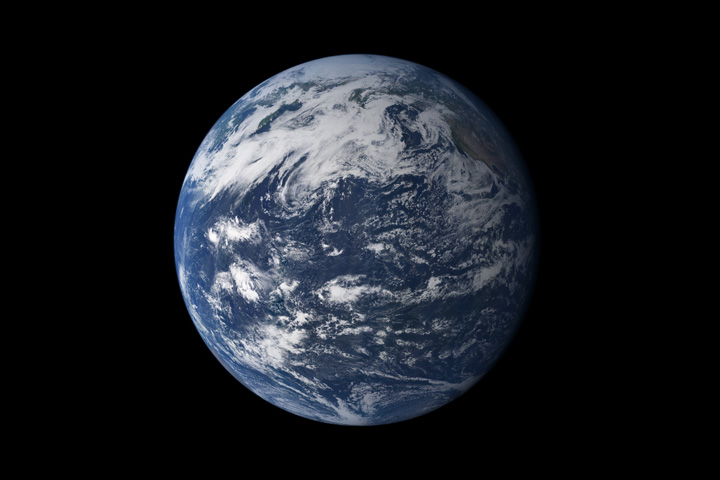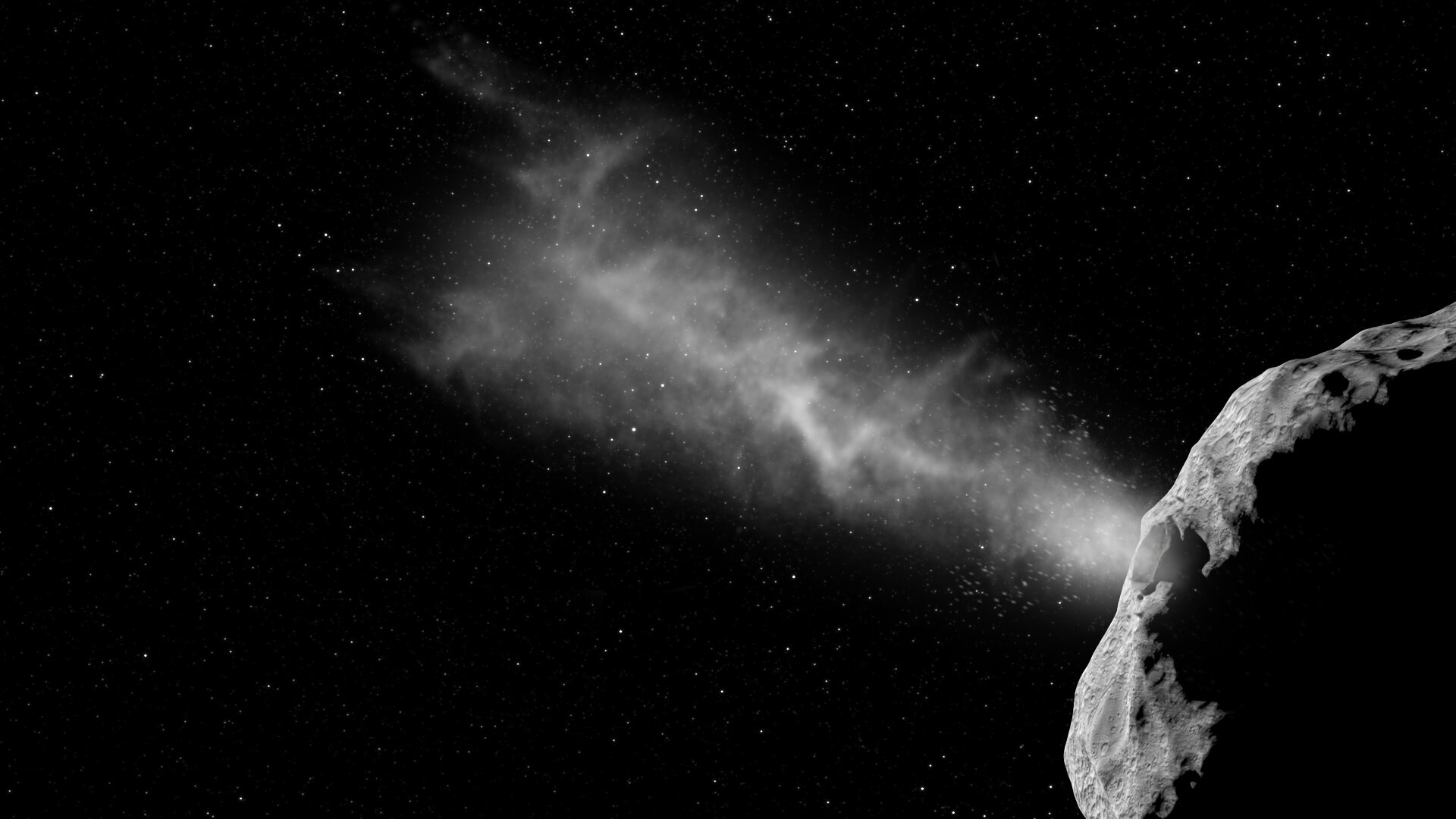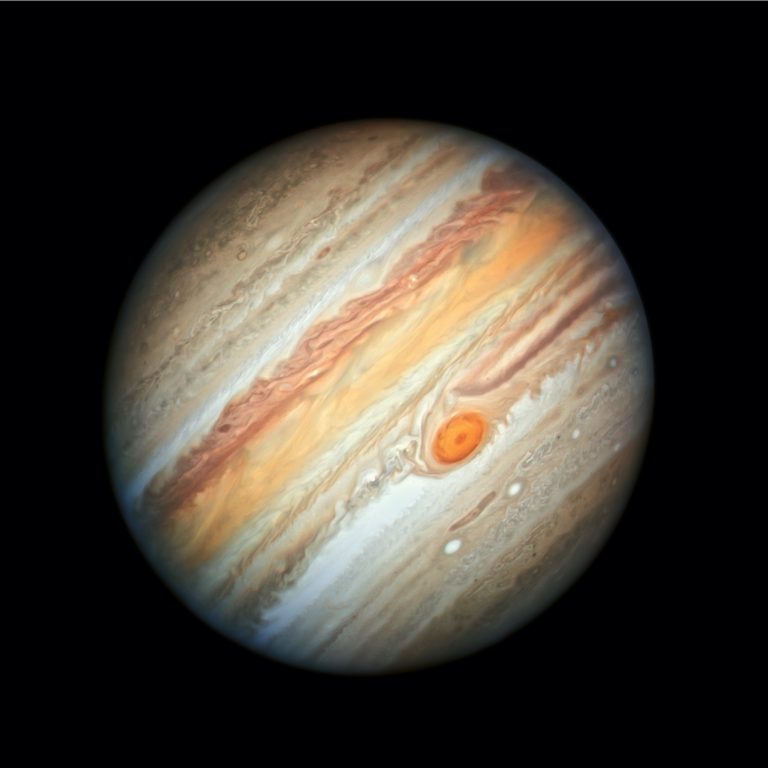Things are heating up again at the SpaceX Starbase in Boca Chica, Texas! With so many static fire and flight tests now behind them and the FAA environmental assessment complete, space exploration enthusiasts have wondered when Elon Musk would attempt to conduct an orbital flight with the Starship prototype. As of Tuesday, October 11th, the Starship 24 (SN24) and Booster 7 (BN7) prototypes were once again seen fully stacked on the orbital launch pad, leading many to wonder if the long-awaited orbital flight is imminent!
Continue reading “Starship and Super Heavy are Stacked up Again. How Long Until They fly?”NASA has Built a Collection of Instruments That Will Search for Life Inside Europa and Enceladus

One of the most exciting aspects of space exploration today is how the field of astrobiology – the search for life in our Universe – has become so prominent. In the coming years, many robotic and even crewed missions will be bound for Mars that will aid in the ongoing search for life there. Beyond Mars, missions are planned for the outer Solar System that will explore satellites and bodies with icy exteriors and interior oceans – otherwise known as “Ocean Worlds.” These include the Jovian satellites Europa and Ganymede and Saturn’s moons Titan and Enceladus.
Similar to how missions to Mars have analyzed soil and rock samples for evidence of past life, the proposed missions will analyze liquid samples for the chemical signatures that we associate with life and biological processes (aka. “biosignatures”). To aid in this search, scientists at NASA’s Jet Propulsion Laboratory have designed the Ocean Worlds Life Surveyor (OWLS), a suite of eight scientific instruments designed to sniff out biosignatures. In the coming decades, this suite could be used by robotic probes bound for “Ocean Worlds” all across the Solar System to search for signs of life.
Continue reading “NASA has Built a Collection of Instruments That Will Search for Life Inside Europa and Enceladus”The Pacific Ocean Will be Gone in 300 Million Years as the World's Continents Drift and Combine
Today, the Earth’s seven continents are distributed across the surface, with North and South America occupying one hemisphere, Africa, Europe, Asia, and Australia occupying the other, and Antarctica sitting alone around the South Pole. However, these continents were arranged in entirely different configurations throughout Earth’s history. On occasion, they formed supercontinents like Gondwana (ca. 550 to 180 million) and Pangaea (ca. 335 to 200 million years ago) that were surrounded by “superoceans.”
Eventually, the Earth’s tectonic plates will come together again to form the world’s next supercontinent. According to new research led by Curtin University in Bentley, Australia, this will happen roughly 200 to 300 million years from now. As they determined through a series of simulations, this will involve the Americas drifting westward until they collide with Australia and Asia (eliminating the Pacific Ocean) and Antarctica moving north to join them. This will give rise to the new supercontinent they have named “Amasia,” which will also have profound implications for life on Earth.
Continue reading “The Pacific Ocean Will be Gone in 300 Million Years as the World's Continents Drift and Combine”The Dark Energy Camera has Captured a Million Images, an Eighth of the Entire sky. Here are Some of its Best Pictures so far

In August 2013, the Dark Energy Survey (DES) began its six-year mission to map thousands of galaxies, supernovae, and patterns in the cosmic structure. This international collaborative effort is dedicated to investigating the mysterious phenomenon known as Dark Energy. This theoretical force counter-acts gravity and accounts for 70% of the Universe’s energy-mass density. Their primary instrument in this mission is the 570-megapixel Dark Energy Camera (DECam), mounted on the Victor M. Blanco 5-meter (16.4 ft) telescope at the Cerro Tlelolo Inter-American Observatory in Chile.
Between 2013 and 2019, the DECam took over one million exposures of the southern night sky and photographed around 2.5 billion astronomical objects – including galaxies, galaxy clusters, stars, comets, asteroids, dwarf planets, and supernovae. For our viewing pleasure, the Dark Energy Survey recently released fifteen spectacular images taken by the DECam during the six-year campaign. These images showcase the capabilities of the DECam, the types of objects it observed, and the sheer beauty of the Universe!
Continue reading “The Dark Energy Camera has Captured a Million Images, an Eighth of the Entire sky. Here are Some of its Best Pictures so far”Underground Liquid Water Detected on Mars? Maybe not
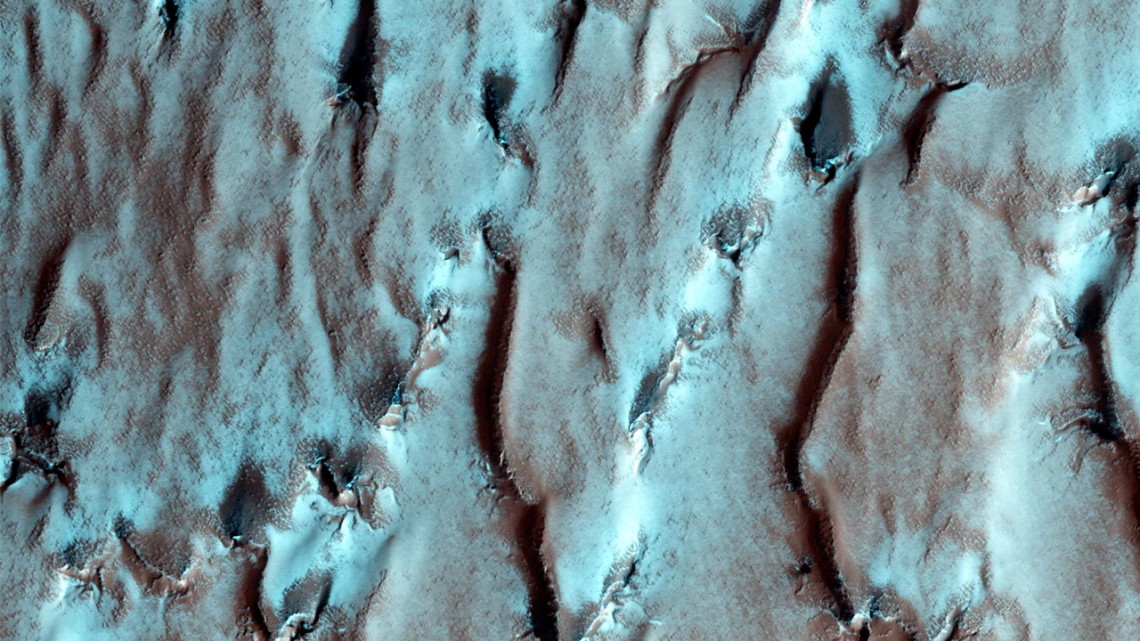
When planning crewed missions to Mars, the key phrase is “follow the water.” When astronauts set down on the Red Planet in the next decade, they will need access to water to meet their basic needs. Following the water is also crucial to our ongoing exploration of Mars and learning more about its past. While all of the water on the Martian surface exists as ice today (the majority locked away in the polar ice caps), it is now known that rivers, lakes, and an ocean covered much of the planet billions of years ago.
Determining where this water went is essential to learning how Mars underwent its historic transformation to become the dry and cold place it is today. Close to twenty years ago, the ESA’s Mars Express orbiter made a huge discovery when it detected what appeared to be a massive deposit of water ice beneath the southern polar region. However, recent findings by a team of researchers from Cornell University indicate that the radar reflections from the South Pole Layered Deposit (SPLD) may be the result of geological layering.
Continue reading “Underground Liquid Water Detected on Mars? Maybe not”The First Telescope Images of DART's Impact are Starting to Arrive
On September 26th, at 23:14 UTC (07:14 PM EST; 04:14 PM PST), NASA’s Double Asteroid Redirect Test (DART) spacecraft successfully struck the 160-meter (525 ft) moonlet Dimorphos that orbits the larger Didymos asteroid. The event was live-streamed all around the world and showed footage from DART’s Didymos Reconnaissance and Asteroid Camera for Optical navigation (DRACO) as it rapidly approached Dimorphos. In the last few seconds, DART was close enough that individual boulders could be seen on the moonlet’s surface.
About 38 seconds after impact, the time it took the signal to reach Earth, the live stream ended, signaling that DART had successfully impacted Dimorphos and was destroyed in the process. Meanwhile, teams of astronomers stretching from the Indian Ocean to the Arabian Peninsula watched the impact with their telescopes. One, in particular – the Les Makes Observatory on the island of Le Reunion in the Indian Ocean – captured multiple images of the impact. These were used to create a real-time video and show the asteroid brightening as it was pushed away, followed by material ejected from the surface.
Continue reading “The First Telescope Images of DART's Impact are Starting to Arrive”A Fascinating Look at Jupiter's Clouds Where the Light Intensity is Converted Into 3D
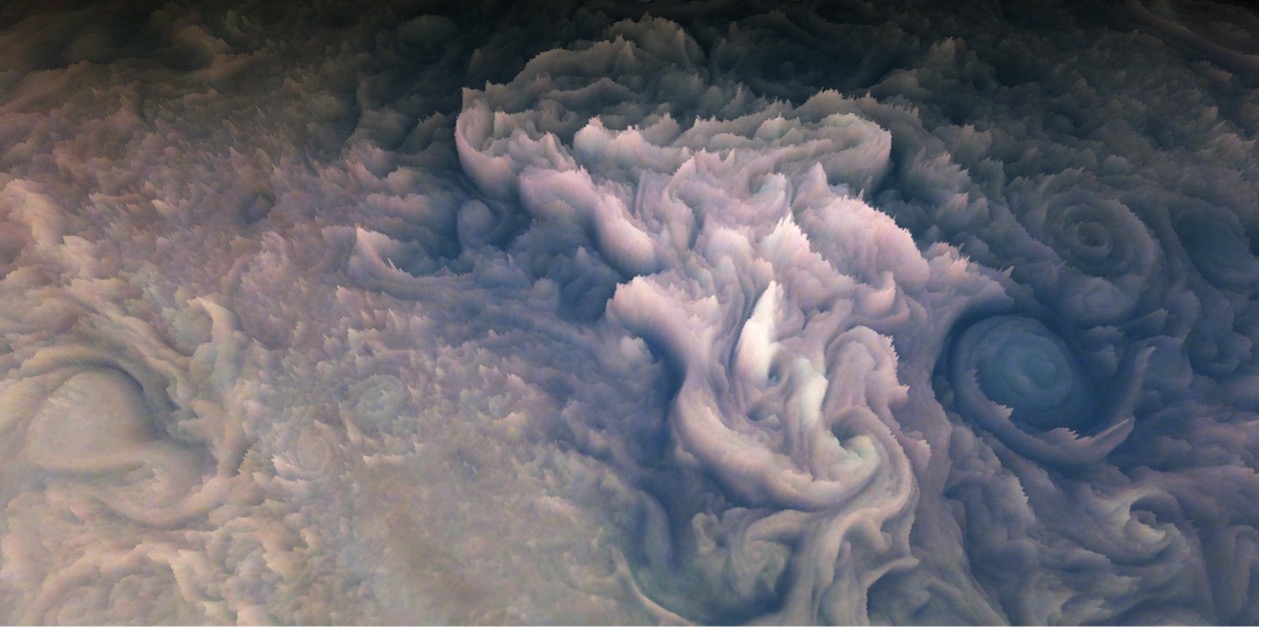
In July 2016, NASA’s Juno space probe reached Jupiter, becoming the second spacecraft in history to orbit the gas giant (the first being the Galileo probe that orbited Jupiter from 1995 to 2003). The data it has sent back has led to new revelations about the Jovian atmosphere, magnetosphere, gravitational field, structure, and composition. While its primary mission was intended to only last until 2018, a mission extension means that Juno will continue to orbit Jupiter’s poles (a perijove maneuver) and send back stunning images and data until 2025.
Recently, a team of citizen scientists led by mathematician and software developer Gerald Eichstädt used images taken by the probe’s visible-light camera/telescope (the JunoCam) to create a 3D animation of Jupiter’s upper atmosphere. Eichstädt’s animation was presented at the 2022 Europlanet Science Congress (EPSC), which took place from September 18 – 23 in Granada, and shows the relative heights of the cloud tops of Jupiter that reveal delicately textured swirls and peaks. Eichstädt’s work also showcased the potential for citizen science and public engagement with today’s missions.
Continue reading “A Fascinating Look at Jupiter's Clouds Where the Light Intensity is Converted Into 3D”Upcoming Missions Could Search for Ancient Alien Technology Within the Solar System
Over sixty years ago, the first search for extraterrestrial intelligence (SETI), known as Project Ozma, was conducted. This campaign was led by legendary astronomer Frank Drake, which relied on the 85-1 Tatel Telescope at the Green Bank Observatory in West Virginia to listen to Tau Ceti and Epsilon Eridani for any signs of radio transmissions. Since then, the field of SETI has become more sophisticated thanks to more advanced radio telescopes, improved data analysis, and international collaboration. In the coming years, SETI will also benefit from advances in exoplanet studies and next-generation instruments and surveys.
In addition to examining exoplanets for signs of technological activity (aka. “technosignatures”), there are also those who recommend that we look for them here at home. Examples include the Galileo Project, which is dedicated to studying interstellar objects (ISOs) and unidentified aerial phenomena (UAP). There’s also the Penn State Extraterrestrial Intelligence Center, a research group dedicated to advancing SETI through the search for technosignatures. In a recent paper, they explain how future SETI efforts should consider looking for extraterrestrial technology in our Solar System.
Continue reading “Upcoming Missions Could Search for Ancient Alien Technology Within the Solar System”TESS Finds a Super-Earth and two Mini-Neptunes in a Single System
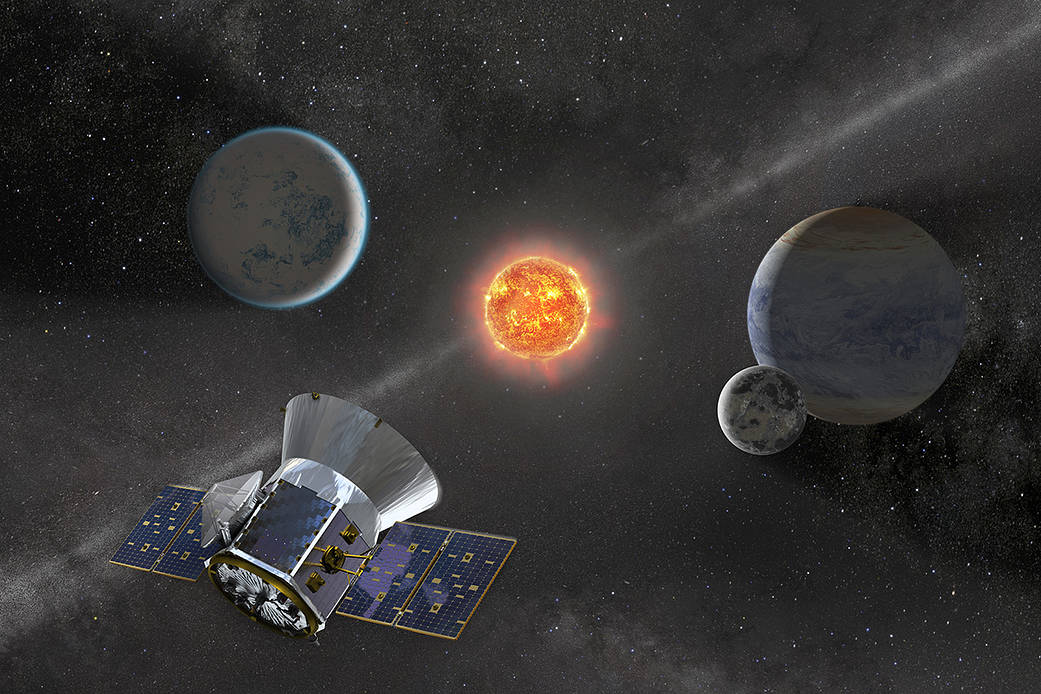
The field of extrasolar planet studies continues to grow by leaps and bounds. Currently, 5,090 exoplanets have been confirmed in 3,816 systems, and another 8,933 candidates are awaiting confirmation. The majority of these have been Neptune-like gas giants (1,779), gas giants comparable to Jupiter or Saturn (1,536), and rocky planets many times the size of Earth (1,582). The most effective means for finding exoplanets has been the Transit Method (aka. Transit Photometry), where periodic dips in a star’s brightness are seen as an indication of a planet passing in front of its star (transiting) relative to the observer.
Using data from NASA’s Transiting Exoplanet Survey Satellite (TESS), an international team of astronomers has discovered a three-planet system orbiting a Sun-like star (HD 22946, or TOI 11) located about 205.5 light-years. Based on size estimates yielded from their transits, the team theorizes that these exoplanets consist of a rocky planet several times the size of Earth (a Super-Earth) and two gas giants smaller than Neptune. Given its proximity, this system could be ideal for follow-up studies and characterization with the James Webb Space Telescope (JWST).
Continue reading “TESS Finds a Super-Earth and two Mini-Neptunes in a Single System”Jupiter at Opposition 2022, Closest in 59 Years
Be sure to observe Jupiter this week, during its finest apparition of a lifetime.
You’ve never seen Jove like this. Jupiter opposition season for 2022 is upon us tonight, as the King of the Planet shines rising in the east opposite to the setting Sun in the west. This is the very best time to catch Jupiter and its retinue of moons, as they dominate the sky throughout the night. And although Jupiter reaches opposition as seen from the Earth nearly every year, this one is special as it’s the closest to the Earth in our lifetimes, and the nearest for the 21st century.
Continue reading “Jupiter at Opposition 2022, Closest in 59 Years”

